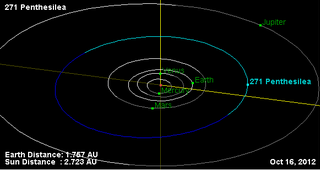Related Research Articles

120 Lachesis is a large main-belt asteroid. It was discovered by French astronomer Alphonse Borrelly on April 10, 1872, and independently by German-American astronomer Christian Heinrich Friedrich Peters on April 11, 1872, then named after Lachesis, one of the Moirai, or Fates, in Greek mythology. A Lachesean occultation of a star occurred in 1999 and was confirmed visually by five observers and once photoelectrically, with the chords yielding an estimated elliptical cross-section of 184 × 144 km.

157 Dejanira is a main belt asteroid that was discovered by Alphonse Borrelly on 1 December 1875, and named after the warlike princess Deianira in Greek mythology. The Dejanira family of asteroids is named after it.

228 Agathe is a stony main belt asteroid, about 9 kilometers in diameter. It was discovered by Johann Palisa on 19 August 1882 at Vienna Observatory, Austria. Photometric observations during 2003 showed a rotation period of 6.48 ± 0.01 hours with a brightness variation of 0.27 ± 0.03 in magnitude. An earlier study yielded results that are consistent with these estimates. Agathe is the lowest numbered asteroid to have an Earth-MOID as low as 0.657 AU (98.3 million km). On 23 August 2029 the asteroid will be 0.659 AU (98.6 million km) from Earth.

271 Penthesilea is a mid-sized main belt asteroid that was discovered by Viktor Knorre on 13 October 1887 in Berlin. It was his last asteroid discovery. The asteroid was named after Penthesilea, the mythical Greek queen of the Amazons.

321 Florentina is an S-type (stony) main belt asteroid with a diameter of 28 km. It was discovered by Johann Palisa on 15 October 1891 in Vienna. He named the asteroid for his daughter, Florentine. Between 1874 and 1923, Palisa discovered a total of 122 asteroids.

400 Ducrosa is a typical Main belt asteroid. It was discovered by Auguste Charlois on 15 March 1895 in Nice.

605 Juvisia is a minor planet, specifically an asteroid orbiting in the asteroid belt that was discovered 27 August 1906 in Heidelberg by German astronomer Max Wolf. It was named after the commune Juvisy-sur-Orge, France, where French astronomer Camille Flammarion had his observatory.
630 Euphemia is a mid-sized Eunomian asteroid.
743 Eugenisis is a minor planet orbiting the Sun that was discovered by German astronomer Franz Kaiser in 1913.
774 Armor is a minor planet orbiting in the main belt. It was discovered on 13 December 1913, in Paris by French astronomer Charles le Morvan and was named after the Celtic region of Armorica. The asteroid is orbiting at a distance of 3.05 AU with a period of 5.32 yr and an eccentricity of 0.169. The orbital plane is inclined by an angle of 5.56° to the plane of the ecliptic.
829 Academia is a minor planet orbiting the Sun. The asteroid is roughly 44 km in diameter and has a low albedo. Photometric measurements of the asteroid made in 2005 at the Palmer Divide Observatory showed a light curve with a period of 7.891 ± 0.005 hours and a brightness variation of 0.44 ± 0.02 in magnitude.
916 America is a minor planet orbiting the Sun in the main belt between Mars and Jupiter.
964 Subamara, is a stony background asteroid from the outer regions of the asteroid belt, approximately 20 kilometers in diameter. It was discovered by Austrian astronomer Johann Palisa at the Vienna Observatory on 27 October 1921. The S-type asteroid has a rotation period of 6.9 hours. It was named for the observatory's "very bitter" observing conditions due to light pollution.
996 Hilaritas is a Themistian asteroid. It was discovered in 1923 by Austrian astronomer Johann Palisa. Following Palisa's death in 1925, this asteroid was named for a "happy or contented mind"; qualities associated with the discoverer.
999 Zachia is a main-belt asteroid that was discovered by German astronomer Karl W. Reinmuth in 1923 and named after Hungarian astronomer Franz Xaver von Zach.
Belopolskya, provisional designation 1923 OS, is a dark Cybele asteroid from the outermost region of the asteroid belt, approximately 75 kilometers (47 mi) in diameter. It was named for Russian astrophysicist Aristarkh Belopolsky.
Sirene, provisional designation 1923 PE, is an eccentric asteroid and sizable Mars-crosser from the central regions of the asteroid belt, approximately 5 kilometers in diameter. It was discovered by German astronomer Karl Reinmuth at the Heidelberg-Königstuhl State Observatory on 31 October 1923. The asteroid was named after the Siren from Greek mythology.
4827 Dares is a larger Jupiter trojan from the Trojan camp, approximately 43 kilometers in diameter. It was discovered on 17 August 1988 by American astronomer Carolyn Shoemaker at the Palomar Observatory in California. The dark D-type asteroid has a rotation period of 19.0 hours. It was named after Dares from Greek mythology.
2311 El Leoncito, provisional designation 1974 TA1, is a dark and reddish asteroid from the outer region of the asteroid belt, approximately 53 kilometers in diameter. The asteroid was discovered by astronomers at Félix Aguilar Observatory at the Leoncito Astronomical Complex in Argentina on 10 October 1974. It was later named after the discovering site.
2892 Filipenko, provisional designation 1983 AX2, is a carbonaceous asteroid from the outer region of the asteroid belt, approximately 60 kilometers in diameter.
References
- ↑ "995 Sternberga (1923 NP)". JPL Small-Body Database . NASA/Jet Propulsion Laboratory . Retrieved 2 May 2016.
- 1 2 Stephens, Robert D. (June 2005), "Rotational periods of 743 Eugenisis, 995 Sternberga, 1185 Nikko 2892 Filipenko, 3144 Brosche, and 3220 Murayama", The Minor Planet Bulletin, 32 (2): 27–28, Bibcode:2005MPBu...32...27S.
- ↑ Schmadel, Lutz D. (2012), Dictionary of Minor Planet Names (6th ed.), Springer, p. 85, ISBN 3642297188.